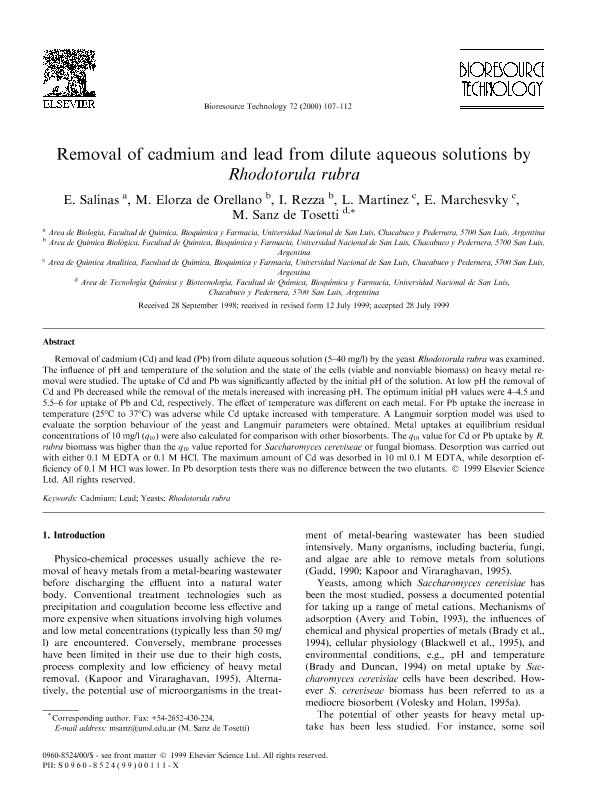Artículo
Removal of cadmium and lead from dilute aqueous solutions by Rhodotorula rubra
Salinas, Eloy; Elorza, Maria Eugenia ; Rezza, Irma Gladis; Marchevsky, Eduardo Jorge
; Rezza, Irma Gladis; Marchevsky, Eduardo Jorge ; Martinez, Luis Dante
; Martinez, Luis Dante ; Sanz Ferramola, Maria Isabel
; Sanz Ferramola, Maria Isabel
 ; Rezza, Irma Gladis; Marchevsky, Eduardo Jorge
; Rezza, Irma Gladis; Marchevsky, Eduardo Jorge ; Martinez, Luis Dante
; Martinez, Luis Dante ; Sanz Ferramola, Maria Isabel
; Sanz Ferramola, Maria Isabel
Fecha de publicación:
04/2000
Editorial:
Elsevier
Revista:
Bioresource Technology
ISSN:
0960-8524
Idioma:
Inglés
Tipo de recurso:
Artículo publicado
Clasificación temática:
Resumen
Removal of cadmium (Cd) and lead (Pb) from dilute aqueous solution (5–40 mg/l) by the yeast Rhodotorula rubra was examined. The influence of pH and temperature of the solution and the state of the cells (viable and nonviable biomass) on heavy metal removal were studied. The uptake of Cd and Pb was significantly affected by the initial pH of the solution. At low pH the removal of Cd and Pb decreased while the removal of the metals increased with increasing pH. The optimum initial pH values were 4–4.5 and 5.5–6 for uptake of Pb and Cd, respectively. The effect of temperature was different on each metal. For Pb uptake the increase in temperature (25°C to 37°C) was adverse while Cd uptake increased with temperature. A Langmuir sorption model was used to evaluate the sorption behaviour of the yeast and Langmuir parameters were obtained. Metal uptakes at equilibrium residual concentrations of 10 mg/l (q10) were also calculated for comparison with other biosorbents. The q10 value for Cd or Pb uptake by R. rubra biomass was higher than the q10 value reported for Saccharomyces cereviseae or fungal biomass. Desorption was carried out with either 0.1 M EDTA or 0.1 M HCl. The maximum amount of Cd was desorbed in 10 ml 0.1 M EDTA, while desorption efficiency of 0.1 M HCl was lower. In Pb desorption tests there was no difference between the two elutants.
Palabras clave:
CADMIUM
,
LEAD
,
YEASTS
,
RHODOTORULA RUBRA
Archivos asociados
Licencia
Identificadores
Colecciones
Articulos(INQUISAL)
Articulos de INST. DE QUIMICA DE SAN LUIS
Articulos de INST. DE QUIMICA DE SAN LUIS
Citación
Salinas, Eloy; Elorza, Maria Eugenia; Rezza, Irma Gladis; Marchevsky, Eduardo Jorge; Martinez, Luis Dante; et al.; Removal of cadmium and lead from dilute aqueous solutions by Rhodotorula rubra; Elsevier; Bioresource Technology; 72; 2; 4-2000; 107-112
Compartir
Altmétricas



